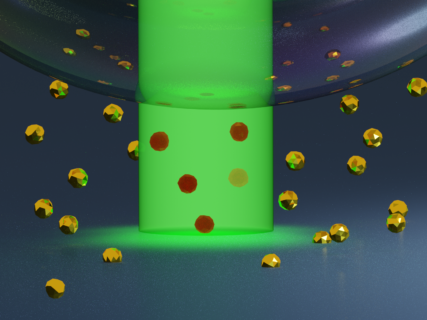GRK research unravelled significant electron beam-induced heating during liquid phase transmission electron microscopy
In a communication accepted by Nanoscale Advances (“Accessing local electron-beam induced temperature changes during in situ liquid-phase transmission electron microscopy”), it was unveiled that the electron beam can significantly heat up a metallic sample during liquid-phase transmission electron microscopy (LPTEM). By transferring an in situ temperature measurement method originally developed in the GRK to LPTEM, a joint team of the GRK projects areas A2 and A1 utilized parallel beam electron diffraction on gold nanoparticles embedded in water. To access electron diffraction, the liquid layer is thinned by introducing an air bubble into the liquid cell, a method widely applied during LPTEM. The work was selected into the Nanoscale Advances HOT Article Collection.
By tracking the subtle changes in the obtained diffraction patterns, B. Fritsch and coworkers discovered a proportionality between the used electron flux density and a local temperature rise of about 9 KŲs/e-. The researchers believe this remarkable increase to originate from two main driving forces: On the one hand, the interaction of the electron beam with the sample is transferring energy to the system. On the other hand, the air bubble is isolating the system and thus hindering an effective heat dissipation.
The results not only question the paradigm that electron beam-induced heating is negligible during LPTEM, but also sketch a pathway how precise control of temperature and radiation chemistry can be achieved in situ even without additional heating capability of the utilized liquid cell.
The article published open access can be found here: https://doi.org/10.1039/D0NA01027H

